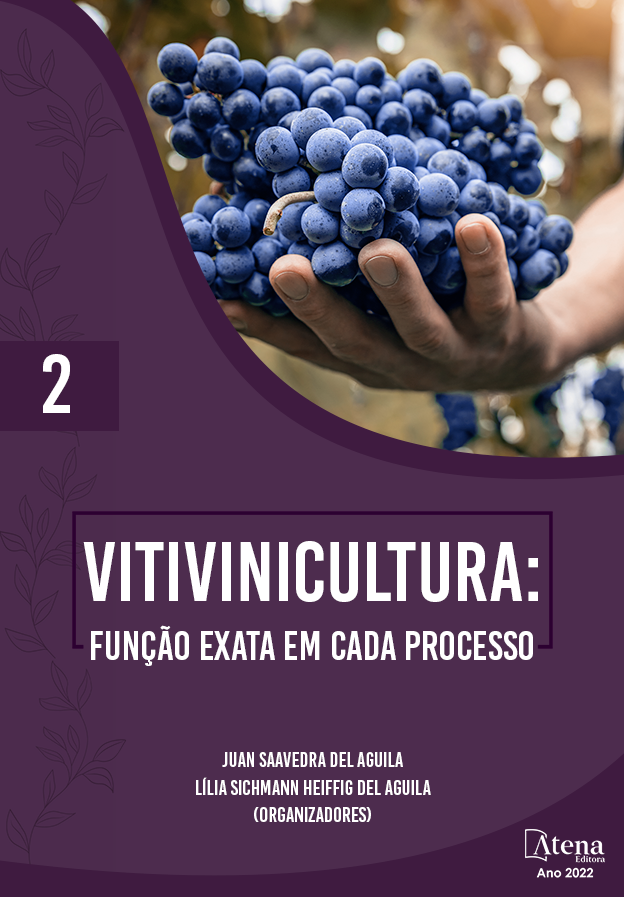
ASPECTOS AGRONÓMICOS INFLUENCIADOS PELA DESFOLHA NA ‘CABERNET SAUVIGNON’
Dentro da Vitivinicultura, práticas culturais como a desfolha pode ser uma ferramenta para melhorar as características agronômicas da cultura da videira. Neste sentido, o presente trabalho avaliou a influência da desfolha sobre aspectos agronómicos na ‘Cabernet Sauvignon’ em Dom Pedrito - RS. O experimento foi desenvolvido pelo Núcleo de Estudo, Pesquisa e Extensão em Enologia (NEPE²) da UNIPAMPA – Campus Dom Pedrito. A desfolha foi realizada em plantas de um vinhedo comercial, de 19 anos de idade, de ‘Cabernet Sauvignon’ enxertado no porta-enxerto ‘SO4’, nas fases de prefloração (17), frutificação (29) e início da maturação ou mudanças da cor (35) - utilizando a escala de Eichhorn & Lorenz, retirando de uma a quatro folhas até que o cacho estivesse descoberto, sendo considerado como controle a desfolha padrão do produtor na fase de maturação plena (38). Foram avaliados: altura e largura do cacho (cm), número de bagas, peso do cacho e baga (g) e, produtividade (kg ha-1). A exceção da variável peso do cacho, para as demais não foram observadas diferenças significativas entre os tratamentos. Conclui-se que os aspectos agronômicos avaliados no presente experimento não foram influenciados pela fase de desfolha na ‘Cabernet Sauvignon’.
ASPECTOS AGRONÓMICOS INFLUENCIADOS PELA DESFOLHA NA ‘CABERNET SAUVIGNON’
-
DOI: 10.22533/at.ed.0942207035
-
Palavras-chave: Vitis vinifera L., Poda Verde, Fotossíntese.
-
Keywords: Vitis vinifera L., Green Pruning, Photosynthesis.
-
Abstract:
Within Viticulture, evaluating cultural practices such as this can be a tool to improve the agronomic characteristics of ‘Cabernet Sauvignon’. In this sense, we sought to study the influence of the leafless on agronomic aspects in 'Cabernet Sauvignon' in Dom Pedrito - RS. The experiment was developed by the “Núcleo de Estudo, Pesquisa e Extensão em Enologia” (NEPE²) of UNIPAMPA – Campus Dom Pedrito. The design was carried out in a 19-year-old Commercial Vineyard, injected into the 'SO4' seed holder, using the Eichhorn & Lorenz Scale, in the phases of pre-flowering (17), fructification (29) and color change (35), with intensity from one to four today until the race was discovered, being considered as the control of the leafless pattern of the producer (38). Evaluated: height and height of the race (cm), number of bays, weight of the race and bay (g) and productivity (kg ha-1). For the variables height of the race, number of bays, weight of bay, productivity and height of the race, no significant differences were observed between the treatments, obtaining an average of 13.35 cm; 88; 1.62 g; 3,785 kg ha-1 and 7.30 cm, respectively. However, for the weight of the race, a significant difference was obtained, hence the highest values were observed in the treatments carried out in the color change, pre-flowering and control, 127.26 g; 120.65 g y; 102.60 g, respectively, differing from the weight of the race in the fructification phase, with an average of 77.78 g. The lower weight of the race obtained in the fructification phase could be associated with the stress generated in the plant, due to the reduction of photo-assimilates to the bays, reflecting in the reduction of the weight of the race in this treatment. Preliminarily, the design carried out in the fructification phase does not result in an increase in the weight of the 'Cabernet Sauvignon' race.
-
Número de páginas: 12
- Alef Robalo Guimarães
- Andreza Santana Afonso
- Sara Barbosa Borghi
- Jansen Moreira Silveira
- Elizete Beatriz Radmann
- Lília Sichmann Heiffig-del Aguila
- Juan Saavedra del Aguila


